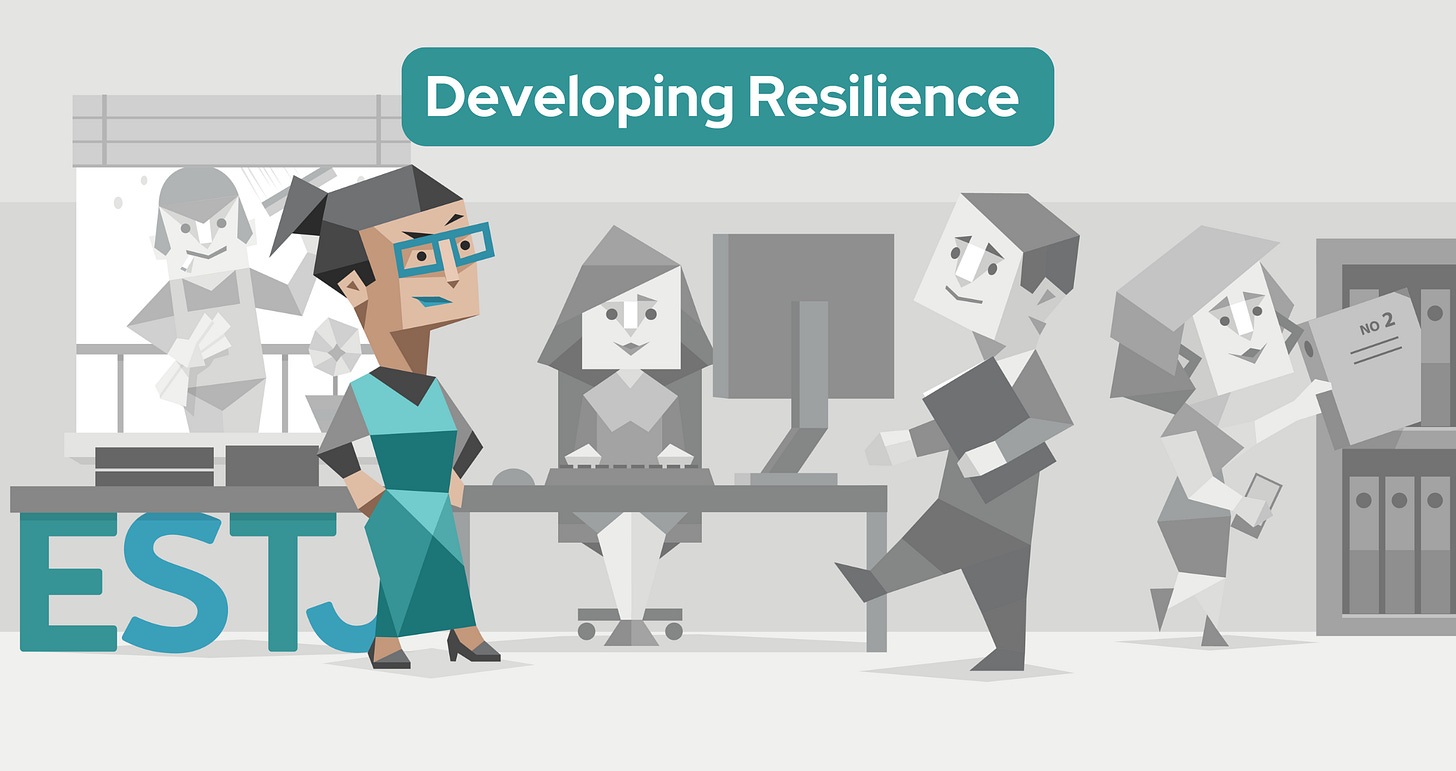Leading Resilient ESTJ (Executive) Personalities
Discover how Sarah the ESTJ strengthens her resilience as her leader transforms moments of frustration into chances for growth
How to Spot ESTJs (Executives):
ESTJs (Executives) share the Extraverted, Observant, Thinking, and Judging personality traits.
In the face of setbacks, they’re often focused on efficiency and results, pushing forward and encouraging everyone on the team to “just get it done.” Their strong work ethic is admirable, but their blunt communication style and tendency to point out flaws may ruffle some feathers.
Short on time? Scroll to the bottom for a 2-minute TL;DR summary of today’s article.
Earlier this month, you met Sarah the Sentinel when she was struggling to persevere through a day that just wasn’t going to plan. She felt frustrated by her boss telling the team to scrap the old plan and follow his new ideas instead.
Then, we wound back the clock and played out an alternate version of this interaction with Sarah the ISFJ (Defender), where she and her boss had a more positive interaction.
Today, we’re going to narrow our focus again and imagine Sarah as a different Sentinel personality: an ESTJ (Executive).
If you recall, three main factors were contributing to Sarah’s lack of resilience at work:
Feeling that her commitment to established processes was being dismissed
Struggling with the lack of clear direction, which undermined her sense of competence
Losing confidence and motivation when the chain of command was disregarded
Let’s see how things would play out for Sarah the ESTJ if she and her boss had more positive interactions in these three areas, shall we? This will help you identify opportunities to adjust your approach in ways that better support your ESTJ team members, making it smoother for them to navigate and adapt to unexpected challenges with more resilience (and less complaining).
Story Time: Helping Sarah the ESTJ Develop Resilience
Let’s set the scene:
Sarah the ESTJ is standing in the conference room where her boss just upended weeks of careful planning by announcing sudden, new ideas that weren’t part of the plan.
Let’s turn back the clock and see how this could have played out differently.
*roll film*
“My boss cares about established processes.”
A notification for a one-on-one meeting with my boss popped up on my screen, scheduled an hour before our regular team meeting. At 2 PM sharp, I entered his office.
“Sarah, I wanted to discuss some changes to the Henderson project with you before our team meeting,” my boss began. “Could you walk me through your current workflow?”
After I explained my process, my boss outlined the new project goals, providing specific objectives. He added, “I’d like you to take the lead on adapting our workflow to these new objectives. Can you draft a new system by Friday?”
I felt a surge of motivation. This was a challenge tailored to my strengths. “Absolutely,” I replied. “Will I have access to the project management software to model these changes?”
“Of course,” my boss nodded. “You’ll have admin access. I trust your judgment on this.”
My boss concluded, “In the team meeting, I’ll announce the changes and your role in restructuring our workflow. I’d like you to briefly outline your approach to the team. Does that work for you?”
I left my boss’s office feeling prepared and valued. By giving me advance notice, clear responsibilities, and the opportunity to contribute my ideas, my boss transformed a potentially frustrating situation into something I had more control over. The trust he placed in me also boosted my confidence. I recognized that even when plans shift unexpectedly, my skills in creating structure and driving efficiency remain valuable.
“My boss tries to provide clear direction amid ambiguity.”
Keep reading with a 7-day free trial
Subscribe to Leadership by 16Personalities to keep reading this post and get 7 days of free access to the full post archives.





